Split Bus Station Stops All Lines Outside Croatia, Reduction in Domestic Lines Likely
March 15, 2020 - The Split Bus Station reacts to the effects of the coronavirus outbreak in Europe.
Due to the coronavirus pandemic, the border regime with Bosnia and Herzegovina and Montenegro has changed since Saturday night. Thus, the director of the Split Bus Station, Mate Jujnovic, said that even before the border decision, he decided to take precautionary measures, which is why he abolished all international lines, reports Slobodna Dalmacija.
In Croatia, all lines are still driving as normal, but probably not for long.
“All lines outside Croatia have been stopped. On Thursday and Friday, the lines to Austria, Germany, Switzerland, and Montenegro were discontinued, and the line to Bosnia and Herzegovina was officially discontinued as of today. The last tour for BiH waited 12 hours at the border. Anyone who has purchased a ticket in advance for any of the canceled lines will receive a refund at the counter where the ticket was purchased,” says Mate Jujnovic, who also noted that on Monday, all Croatian carriers have a meeting at the Ministry of Sea, Transport and Infrastructure.
“So far, everything is running as usual within the country, but I suppose it will be reduced soon. There are no passengers and there is no need to drive so many lines. It is the same for everyone. Tomorrow, all carriers have a meeting at the competent ministry and we will ask everyone to reduce the number of lines within Croatia. It makes no sense that 40 buses run, for example, from Split to Zagreb without any passengers.
We will seek to reduce the number of lines and departures, and again that connections still exist and that the traffic runs as usual,” says Jujnovic.
He also notes that passengers can find all the necessary information on bus routes on their website ak-split.hr.
As the telephone line at the station was always busy, many passengers were probably unable to contact the operator to ask for individual lines. Thus, Jujnovic adds that passengers should search for the line of interest on its website. If they release the timetable, the line is still active. If there is no timetable, that route is no longer departing.
Data is updated continuously so that the web is currently the best and fastest means of information.
For those looking for more comprehensive information about different aspects of coronavirus and Croatia, follow the dedicated TCN section.
How is Split Preparing for Self-Isolation? A Saturday Shopping Trip in Photos
March 14, 2020 - Experts say that panic surrounding coronavirus can be more dangerous than the virus itself. Amid news of panic Croatian supermarket buying, TCN visits supermarkets in Split to see the realities on the ground.
After Croatian Prime Minister Andrej Plenkovic announced that schools would close for two weeks from Monday and that citizens should strictly follow the measures in place to stop the spread of the coronavirus, Croatians kicked into self-isolation gear all over the country.
With this comes the obvious hysteria, which resulted in stories of panic buying around the country. While Croatia didn’t exactly follow the route of Australia, where toilet paper became nearly impossible to find, it was interesting to see how Croatian shoppers chose to prepare for a few weeks in solitude.
After we had a look into how the citizens of Varazdin equipped themselves on Friday, I thought I’d set out for my big shop on Saturday to my neighborhood supermarkets in the Firule area of Split.
I began at Tommy up the street, primarily to stock up on cat food for my furry friends at home.
There had been speculation that the meat shelves would run dry this weekend, and based on this Tommy supermarket, it was true.
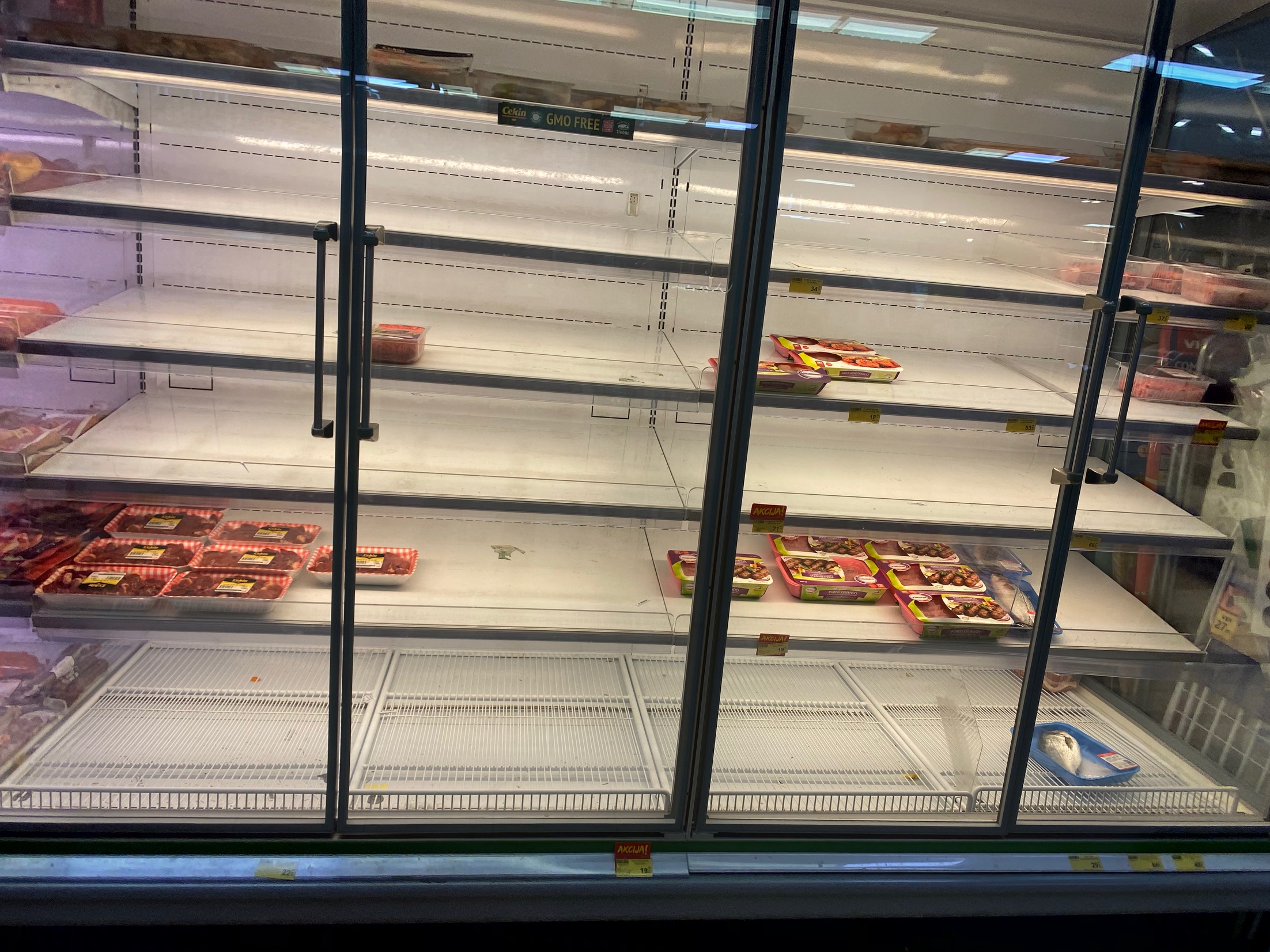
Toilet paper, however, was fully stocked.

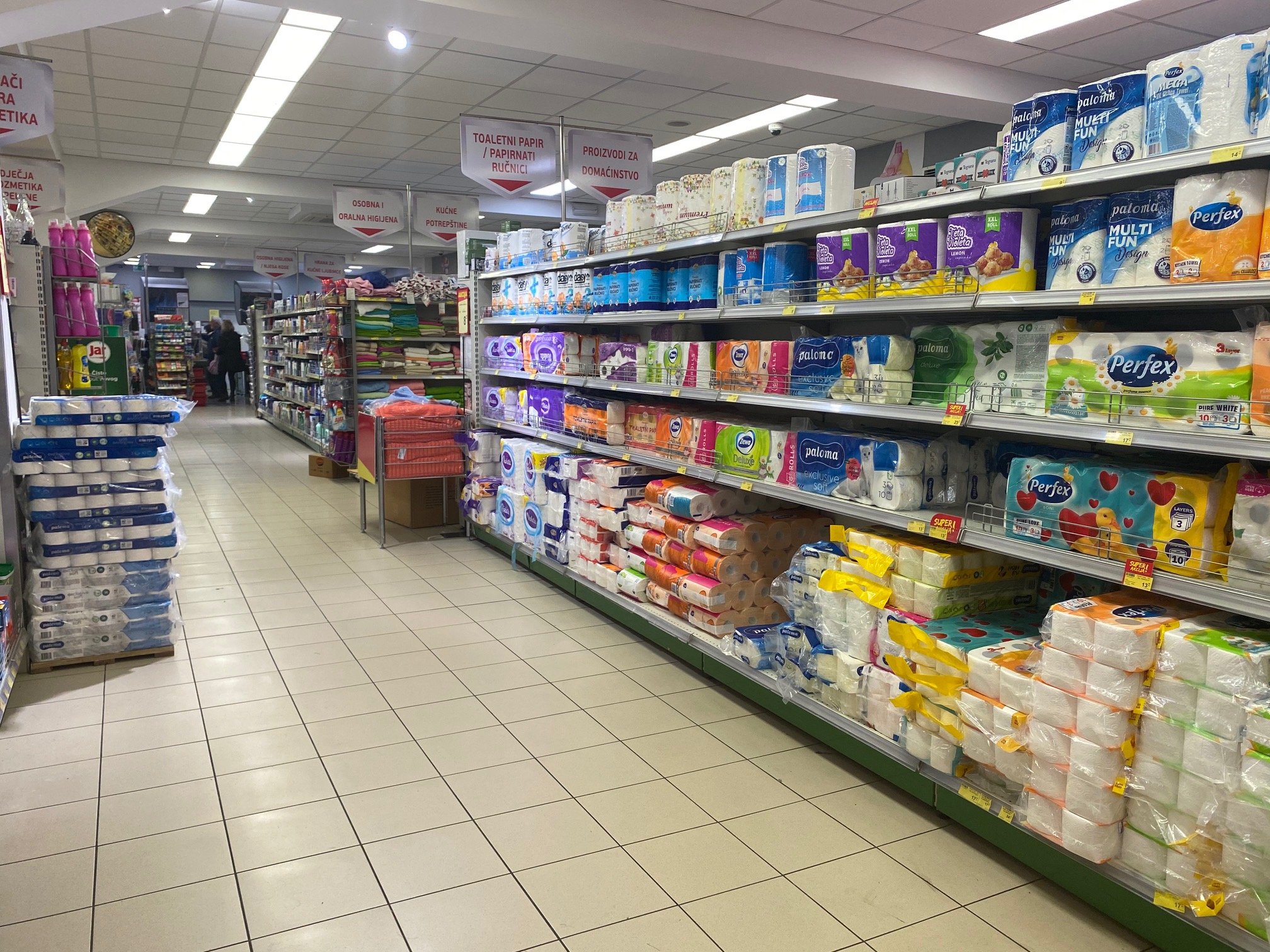
In the United States, pasta shelves emptied quickly. The selection of Barilla was only a bit thinner than usual at this Split Tommy.
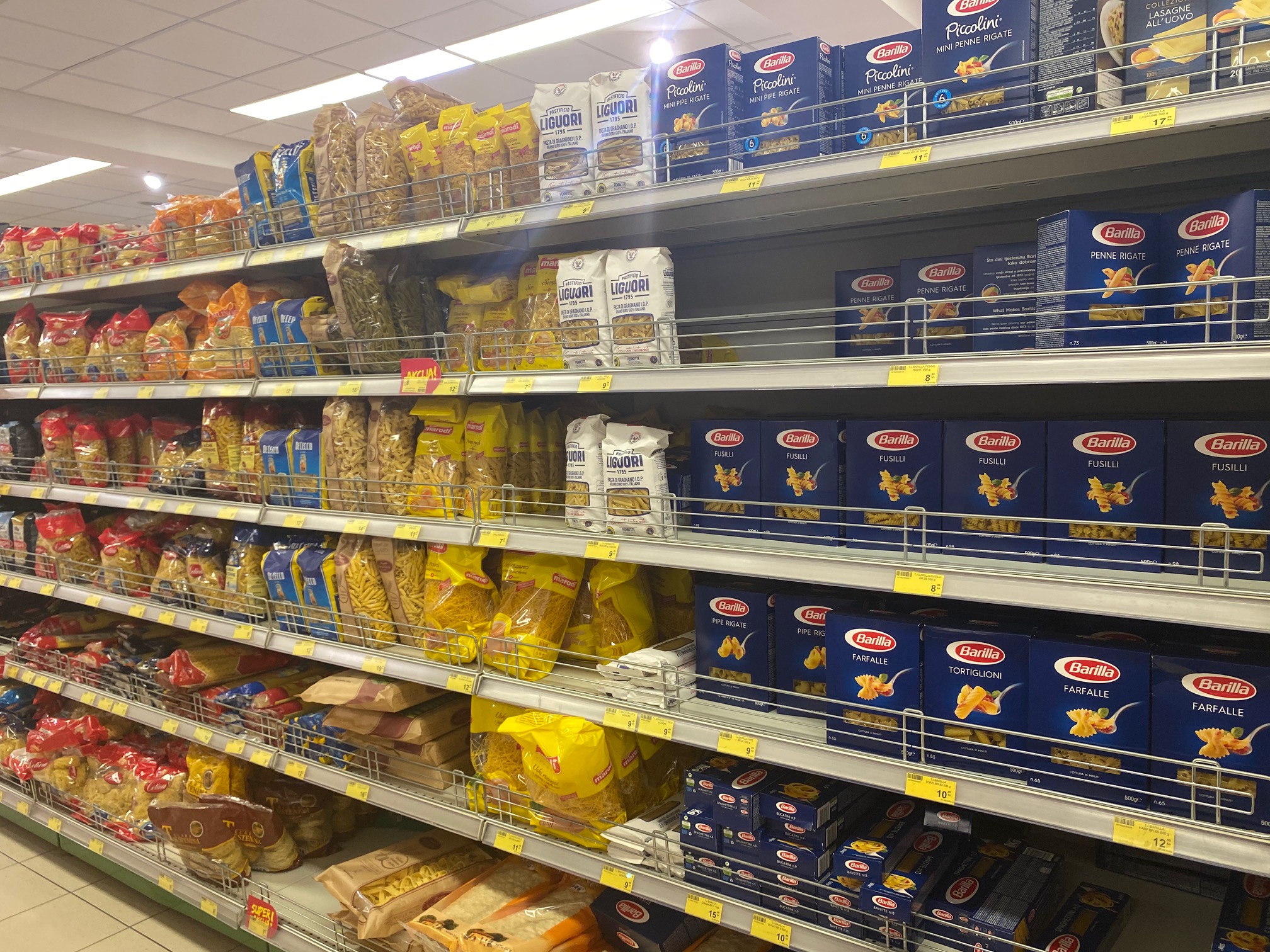
Frozen goods also took a small hit, with fish products the most popular items missing.

Tommy had a sign at the register asking all customers to stand one meter apart.
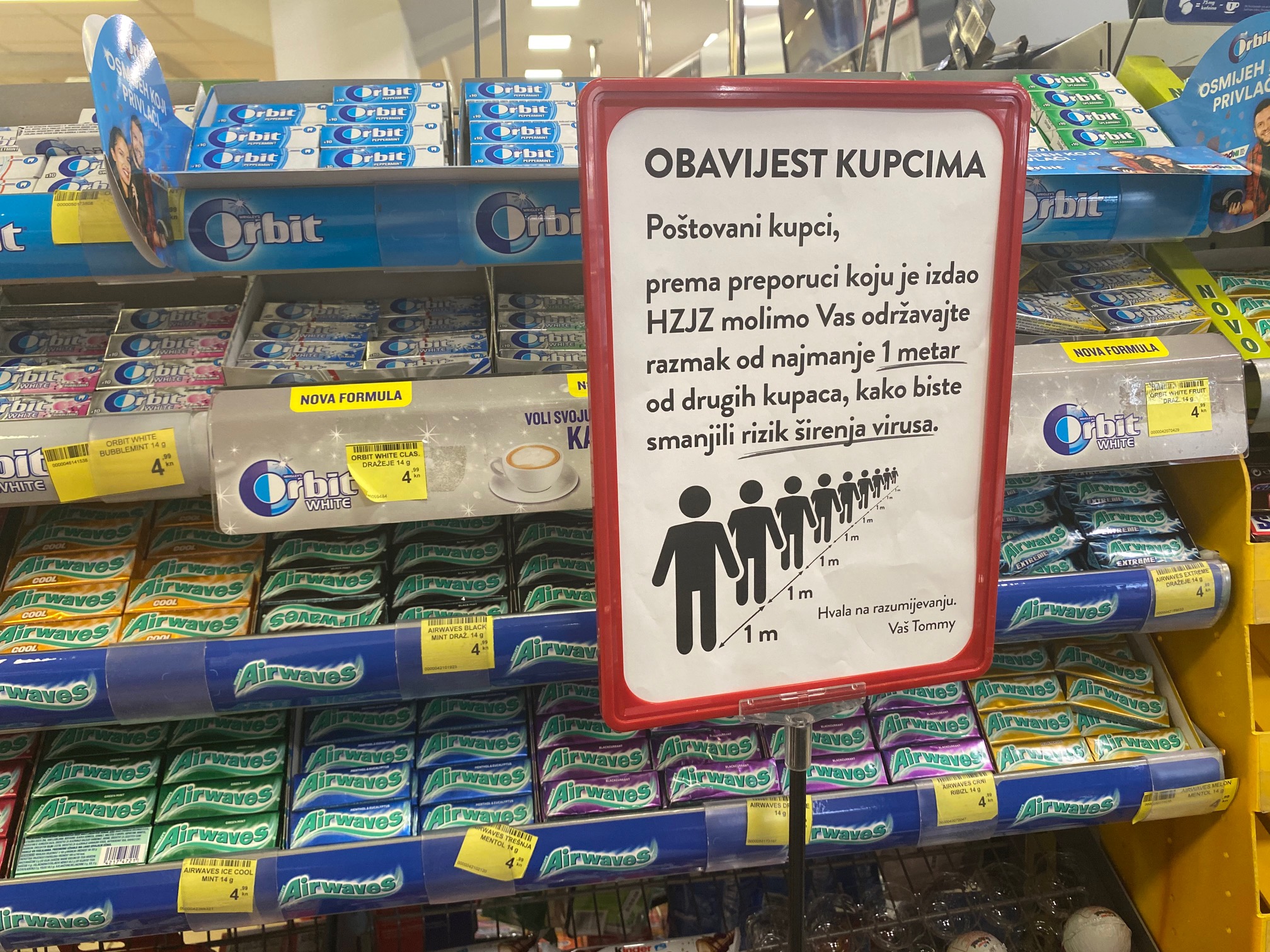
Next up was DM, where toilet paper, paper towels, and tissues were mostly lacking.

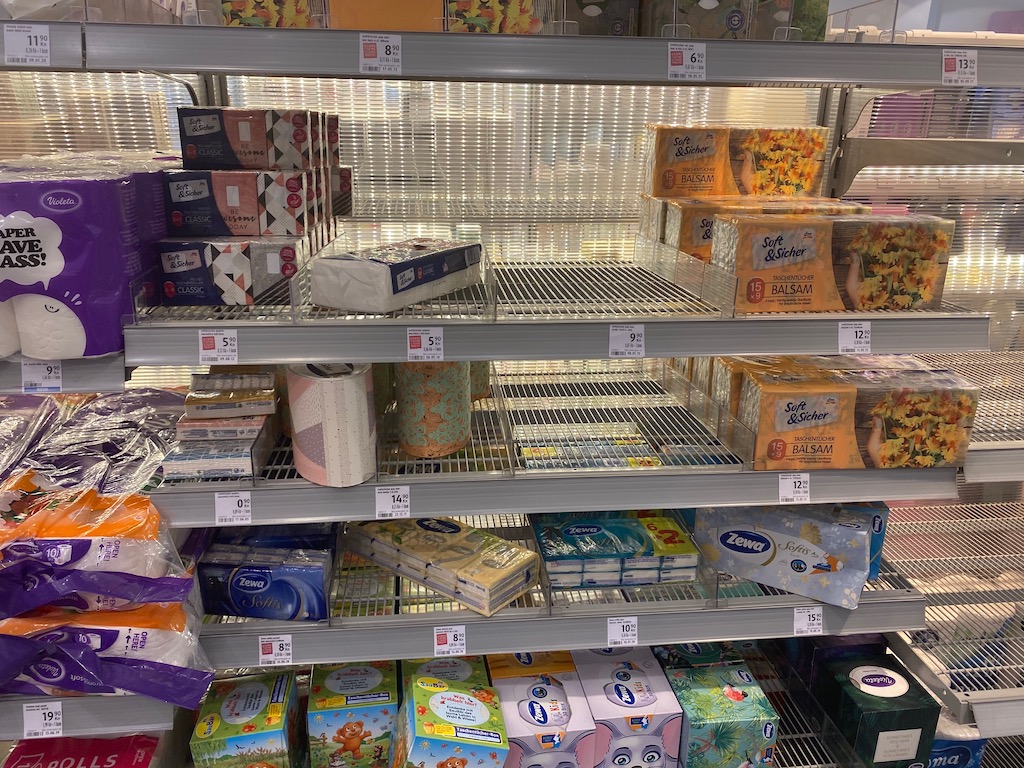
And you'd be lucky to find soap and antibacterial sanitizer near the checkout.
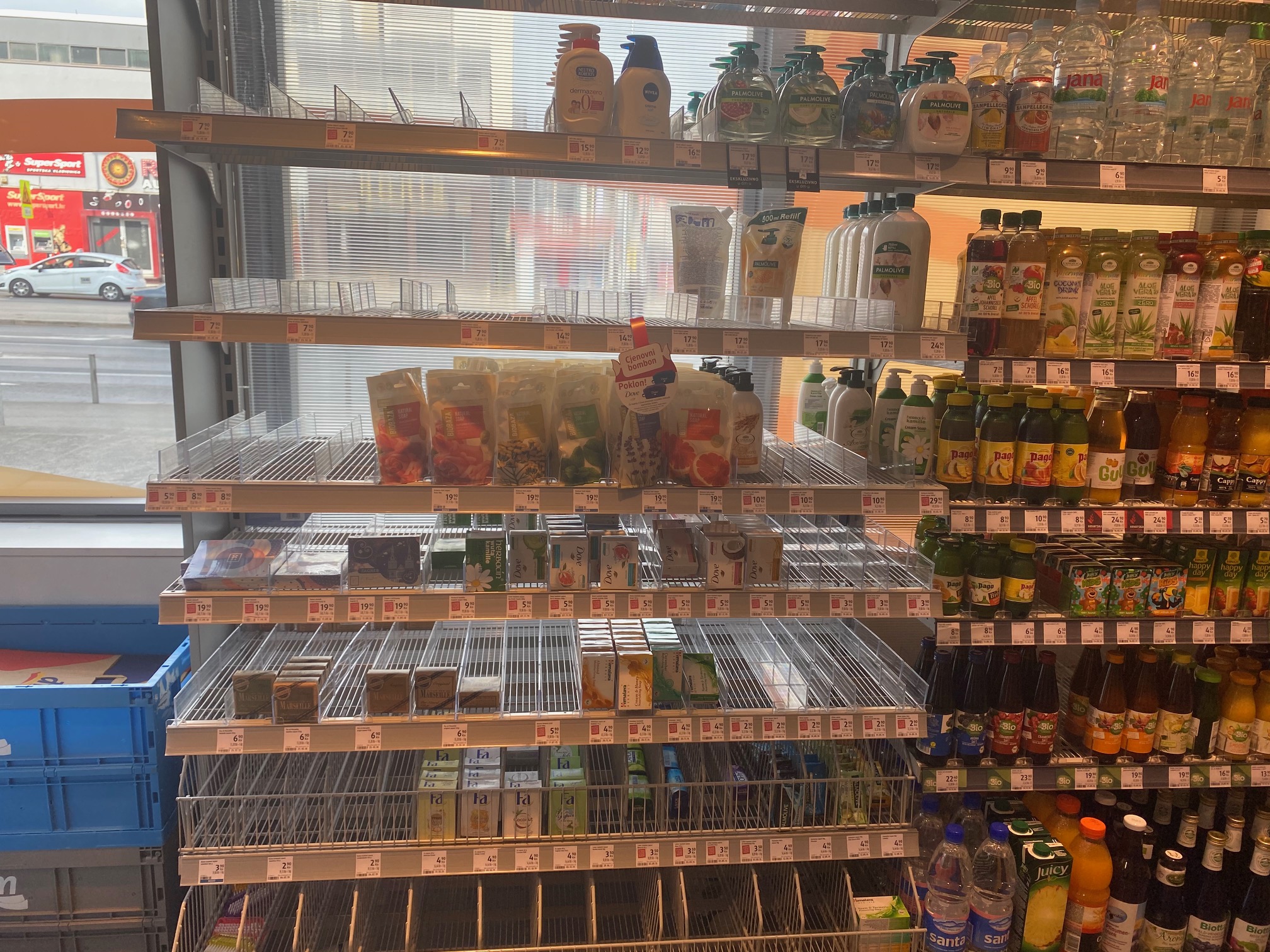
Spar was my final stop, where clerks actively resupplied the aisles with food items.
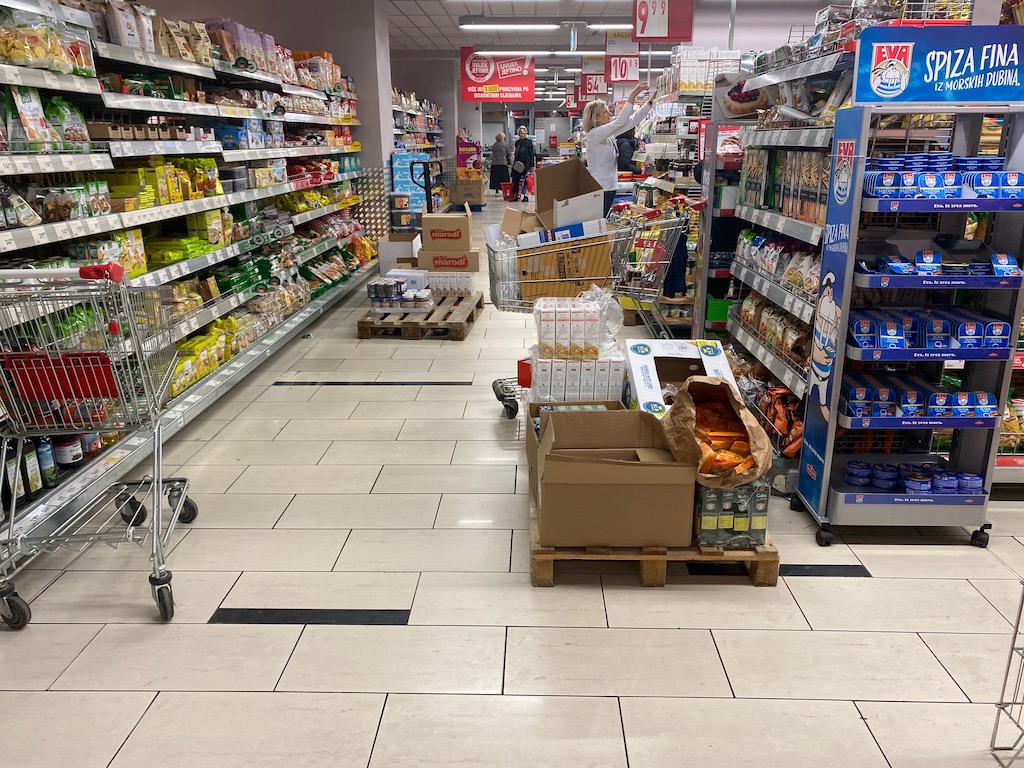
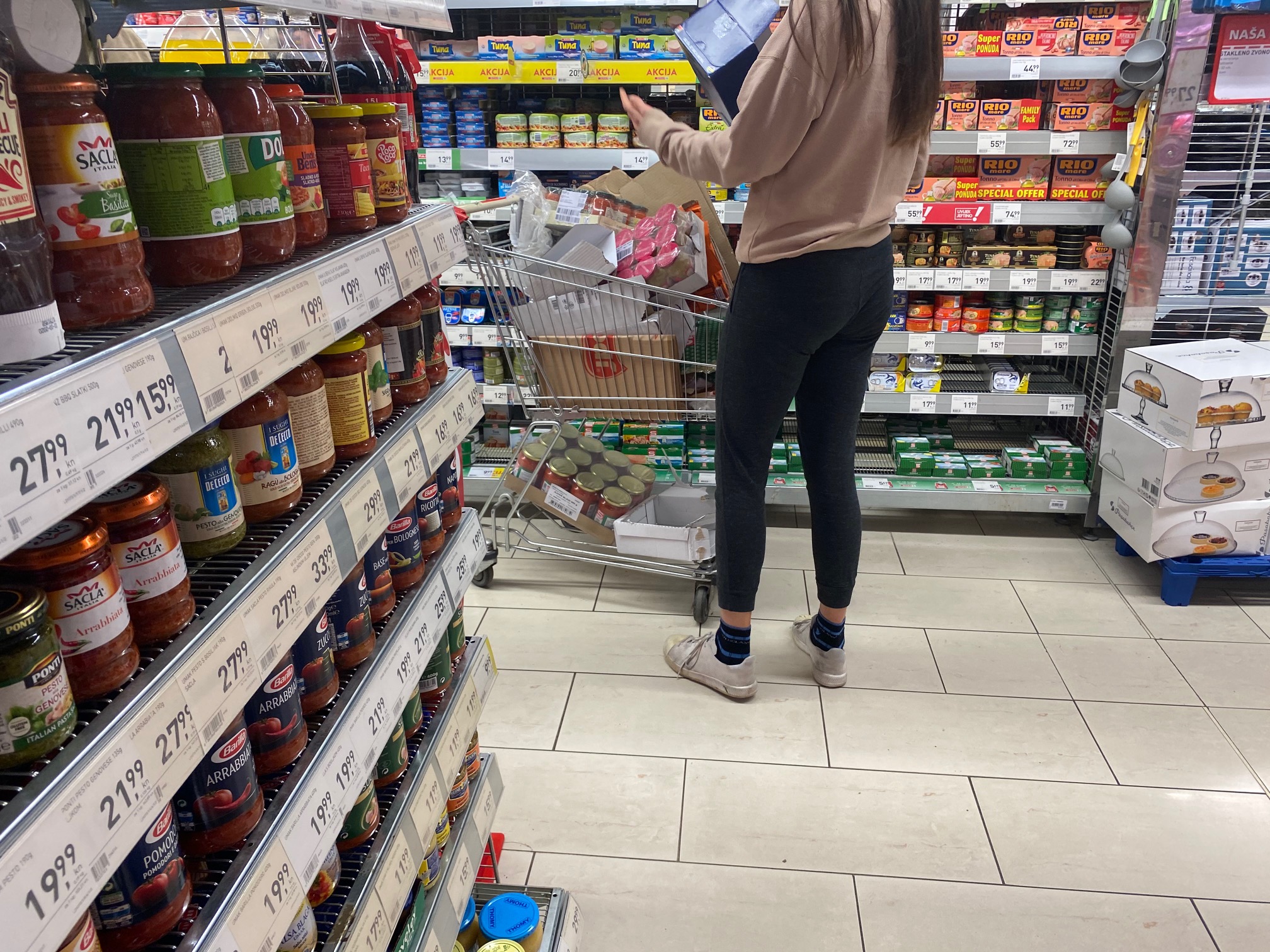
Red apples and lemons were on the low side, however.
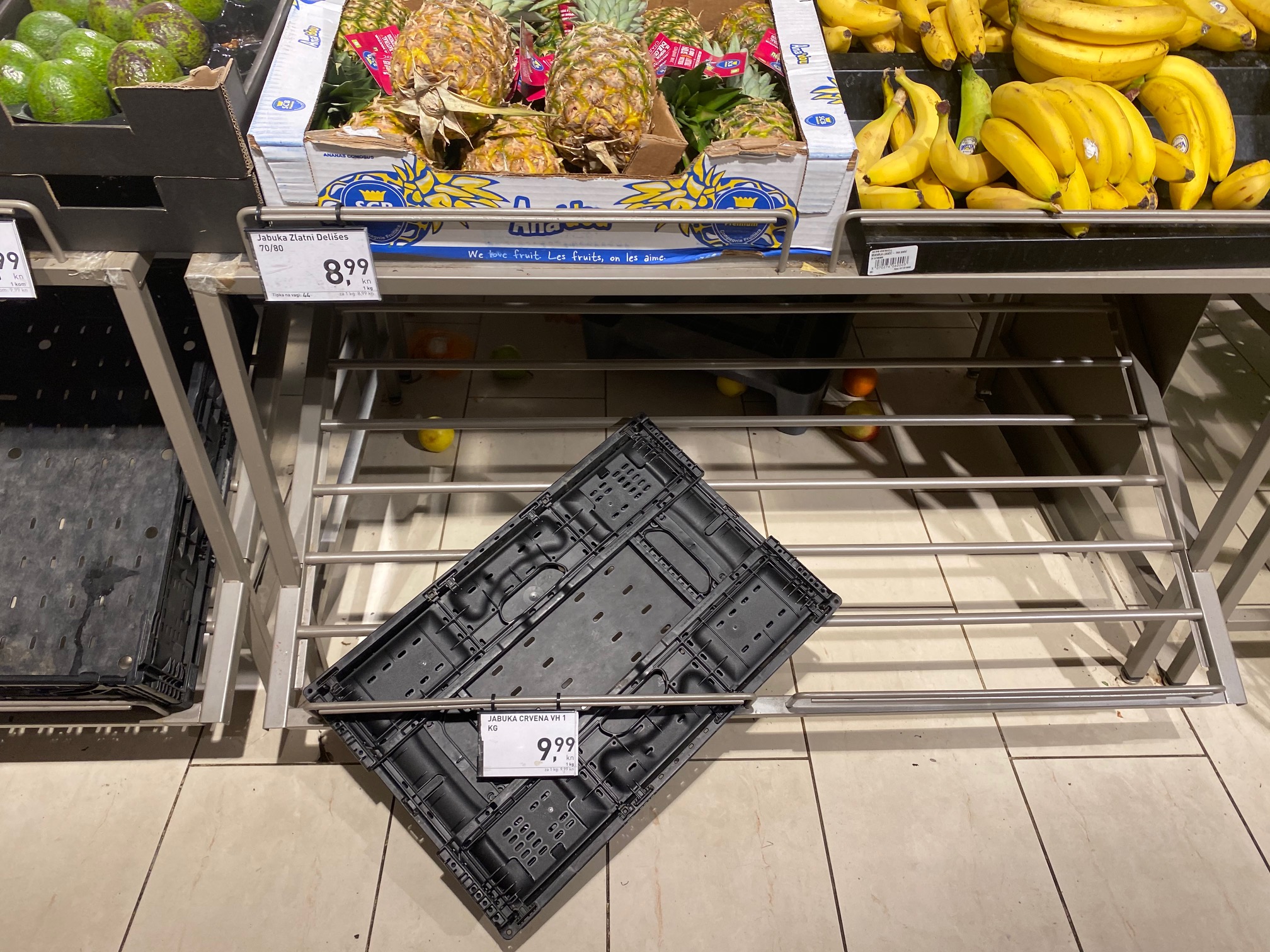
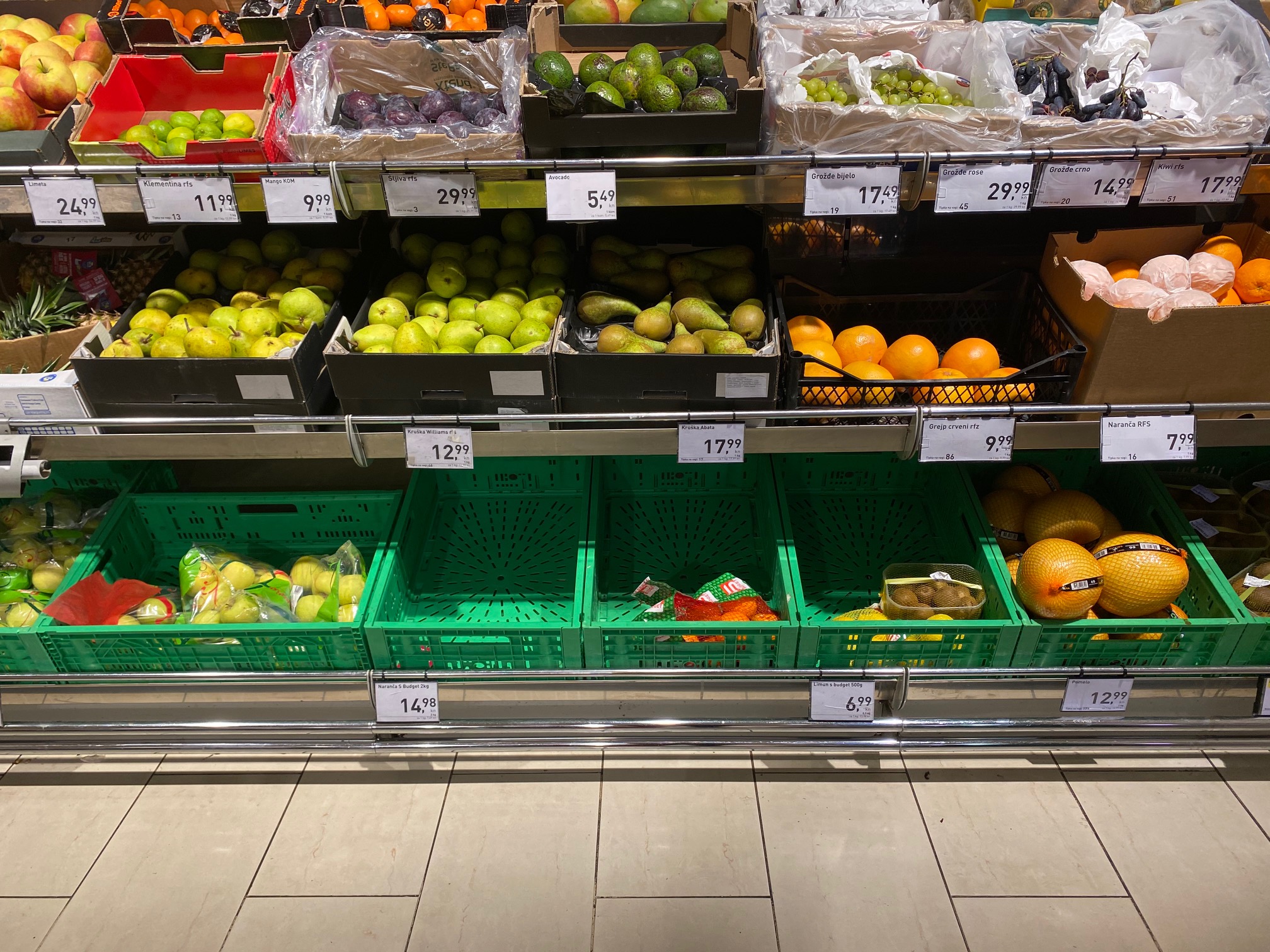
But toilet paper was on sale!
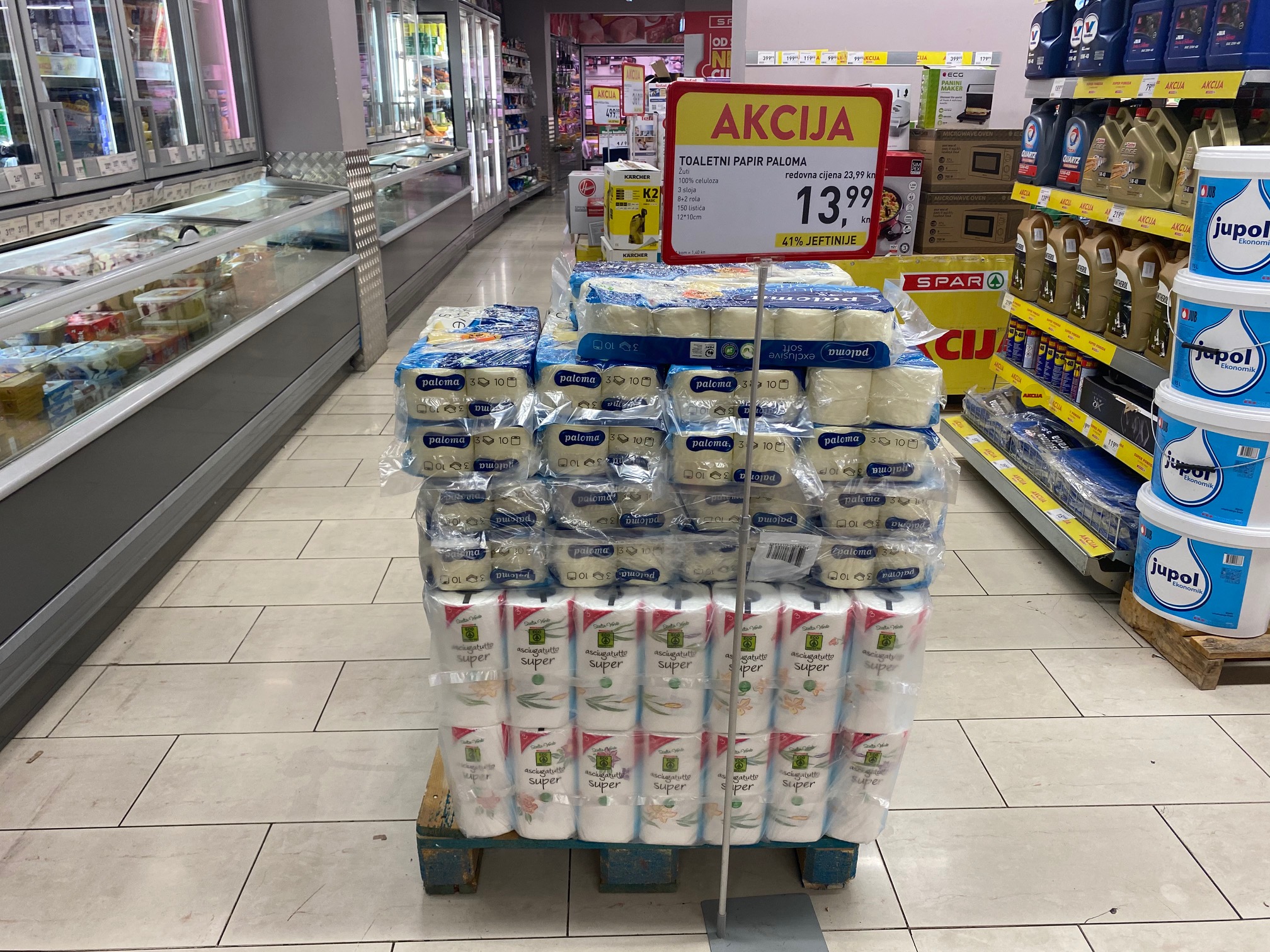
And there was still plenty available.
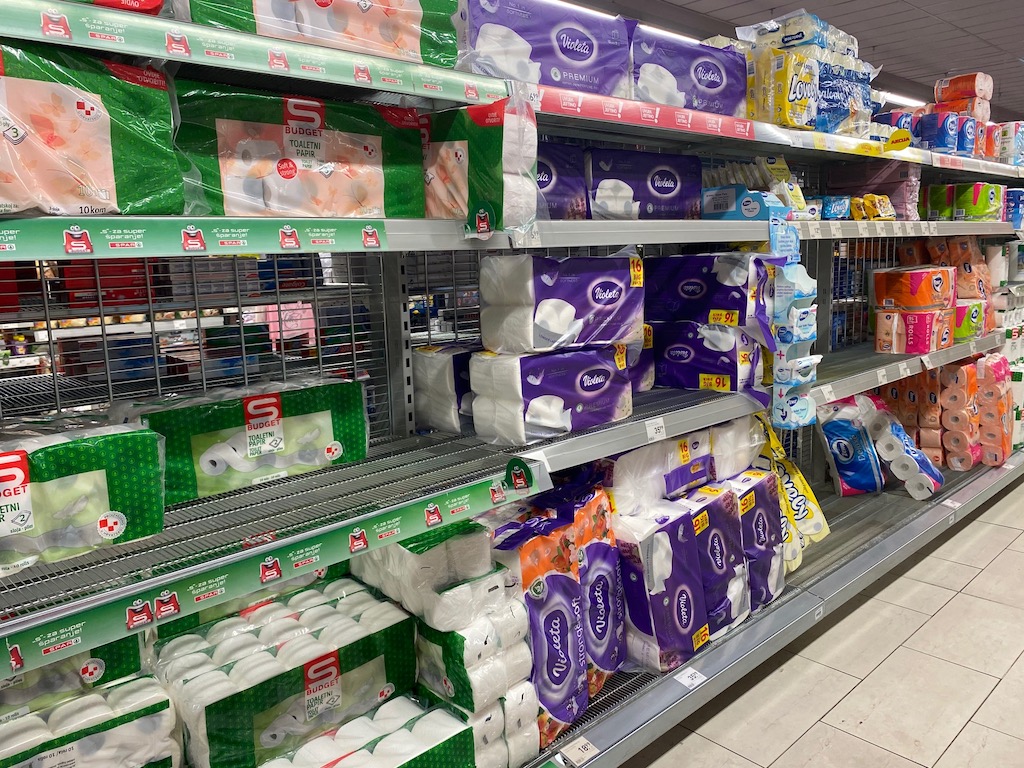
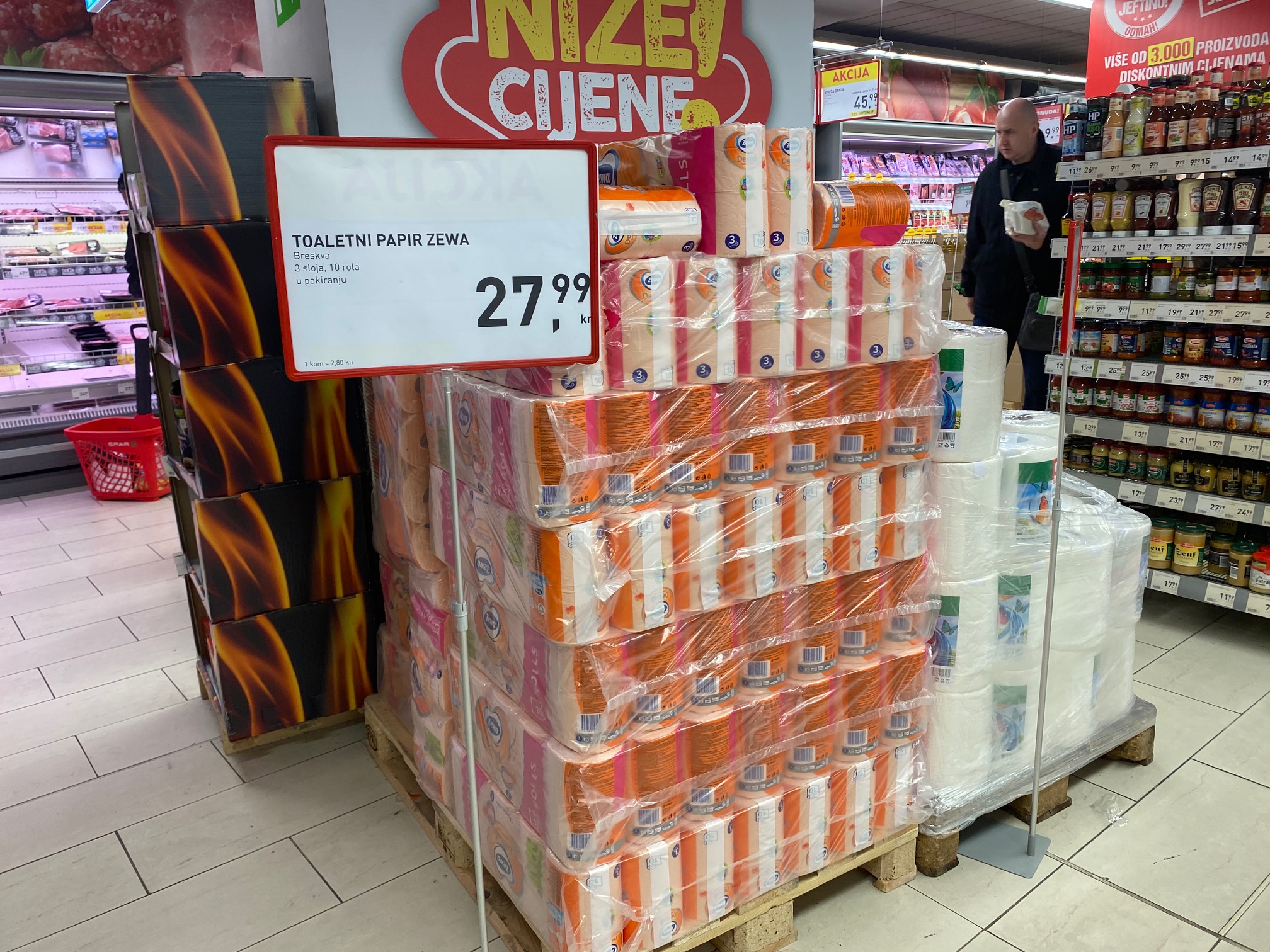
Some bottled water and milk brands could use a refill.
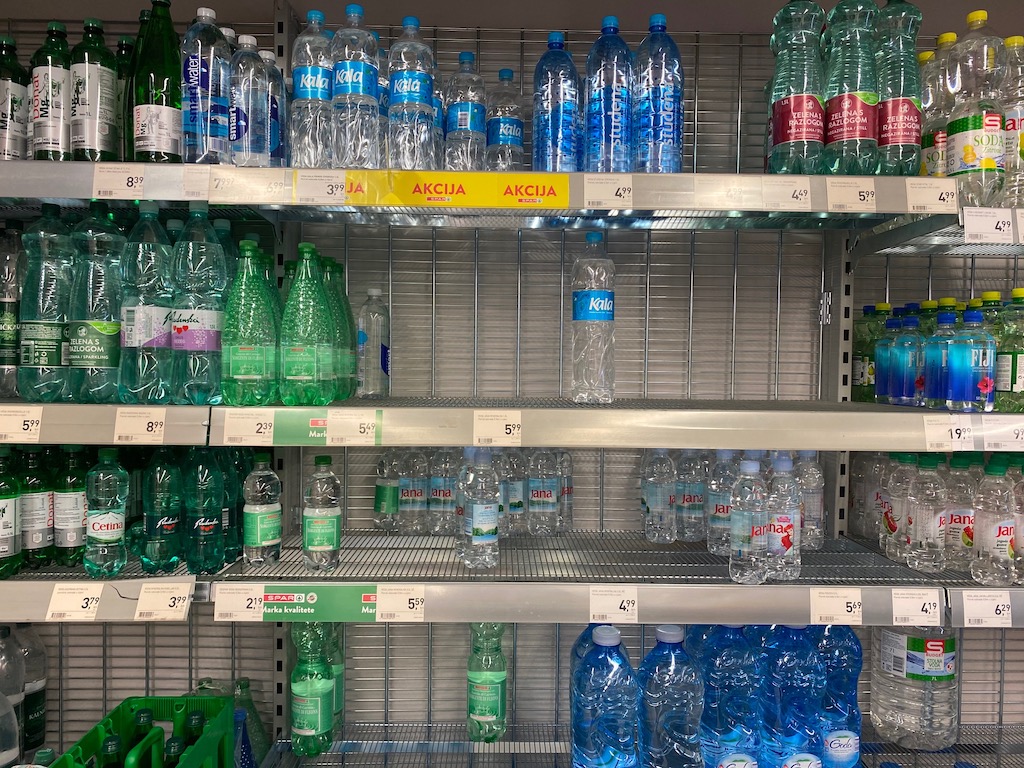
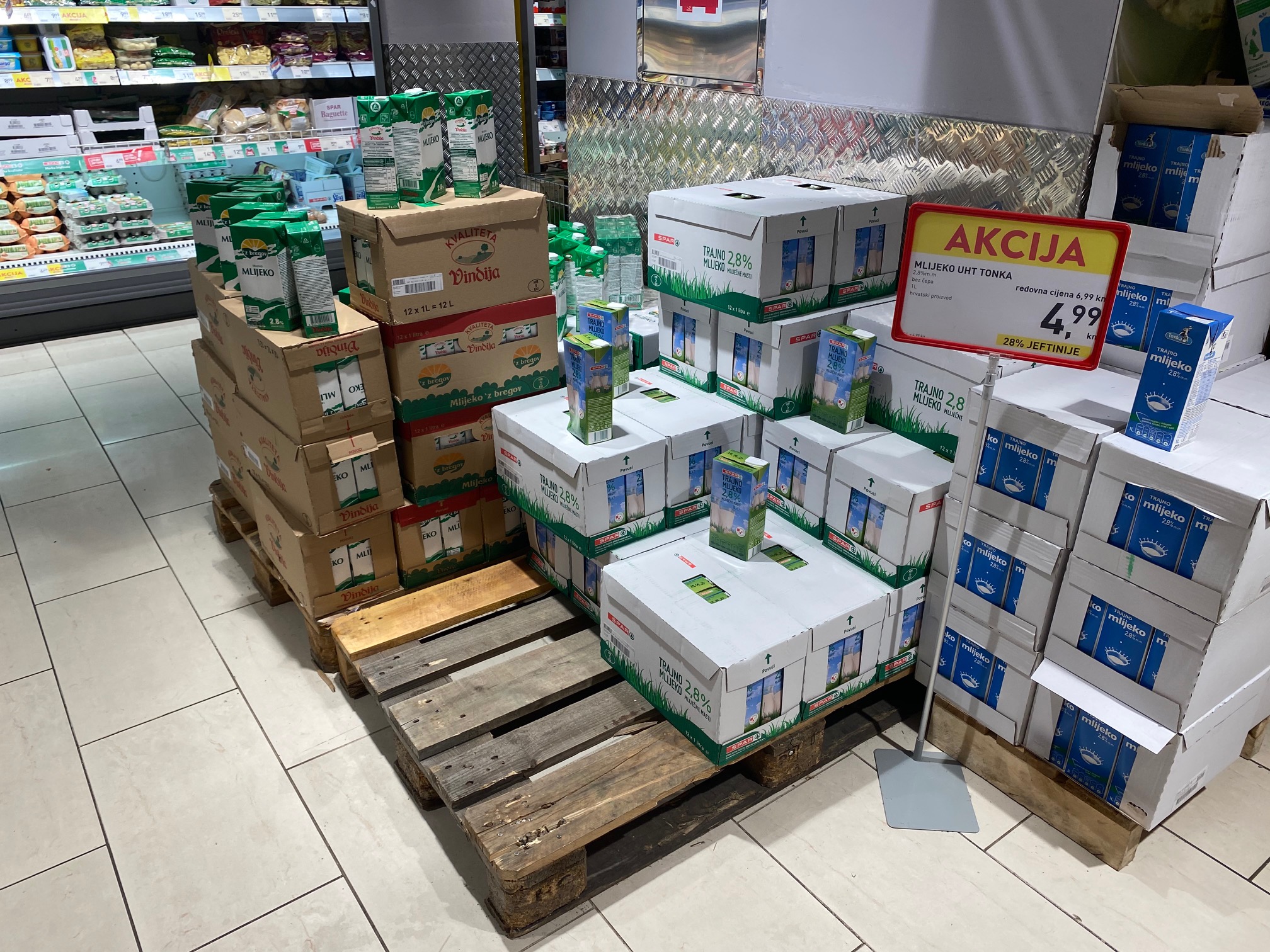
So, how was my self-isolation shopping Saturday in Split? Fortunately, I was able to acquire everything I needed, and shoppers out and about didn't seem panicked, nor did they buy in bulk. It was no busier than a typical Saturday morning shop in the Dalmatian capital.
What have you had trouble finding in Split? Send over your self-isolation shopping photos to This email address is being protected from spambots. You need JavaScript enabled to view it..
For the latest on the coronavirus crisis in Croatia, follow the dedicated TCN section.
Lazaret, the Original Quarantine in Split
March 14, 2020 - As the coronavirus craze takes over Europe, it is good to remember that Split was once one of Europe’s leading quarantine cities.
Slobodna Dalmacija writes that it all started on the Lazaret Coast, where the Tourist Palace and taxi stand sit south of the Green Market (Pazar) today. It was here, at the end of the Middle Ages, that one of the most important commercial and health buildings on the Adriatic was built - the famous Split Lazaret.
During the periods of peace between Venice and the Ottoman Empire, with interruptions during the war years, Dalmatian cities were essential import and export ports of the Venetian-Ottoman trade: business flourished in the Republic of Dubrovnik, the Turkish Neum, but the liveliest was often in Split.
The European standard was clear - large ports had lazarets (named after St. Lazarus, the patron saint of the sick), where not only the loading and unloading of goods took place, but also the disinfection in times of frequent plagues. Namely, a strict and mandatory 40 days of quarantine were put in place in order to detect and prevent possible contagion.
The city's port, the busiest of all on the eastern Adriatic coast, lacked adequate space for these jobs. The goods were stored in the cellars of Diocletian's Palace, but the isolation of citizens from infrequently infected Eastern goods was poor.
Therefore, in the 16th century, a plan was developed to build a spacious and important lazaret for the citizens.
The draft was made by Daniel Rodriguez (Rodrigo), a Venetian Jew of Portuguese descent.
Seeing that the Turks wanted to establish its own lazaret at the mouth of the Neretva, as did the people of Dubrovnik, the Venetian Republic accepted his plan. In 1580, Rodrigo began with his own means of building a quarantine, a lazaret, and then the state continued, but under his supervision.
But everything has its price. According to art historian Dr. Dusko Keckemet, as compensation for his plan and expense, Rodrigo demanded that the Venetian Republic receive a colony of Jews exiled from Spain to Marjan, according to which its laws were much more lenient than other European countries that did not favor them.
The settled Sephardic Jews were given a part of the settlement within the walls of the Palace, an area whose name we have inherited through the informal toponym 'Get', and their successors over the centuries have left a large mark. The Lazaret of Split attracted abundant goods, not only from the Middle East but also from the Far East. Therefore, Split bore the prestigious title - 'the golden ring between the East and Venice'.
The space was rebuilt several times, and relatively quickly became one of the best-equipped lazarets in Europe at the time.
Dr. Kecskemet states that it exceeded the length of the facade of Diocletian's Palace in size.
It was about 200 meters long and about 100 meters wide.
Protective health regulations were stringent, but they did not always prevent infectious diseases. Before the quarantine was built, epidemics of "black death" were more frequent in Split, in the 14th, 15th and 16th centuries, but after the lazaret was built, they were less frequent. They were recorded in 1607, 1731, 1763 and last in 1784. The extent of the tragedy is evidenced by the fact that between March 29 and July 30, 1784, 1264 people died and the city had only a few thousand inhabitants at that time.
The lazaret had several courtyards with wells running sulfuric water for rinsing goods, health workers, security guards, caravan barns and warehouses for goods. It also included the church of Sv. Roko, which was affected by epidemics, especially plague, and a special room for conversations of isolated people with the outside world.
According to Professor Snjezana Perojevic from the Department of Construction Heritage at the Faculty of Civil Engineering, Architecture and Geodesy, goods suitable for the transmission of infection were subjected to a rigorous disinfection process, which was carried out in three primary ways: aeration, immersion, and boiling.
Washing was performed in water with vinegar or in the sea. The animals were also washed with vinegar water and had to go through the pools before entering the village. All textile raw materials, leather, fur, woven and knitted fabrics, carpets, bedspreads and even tobacco were ventilated.
The job of a disinfectant is also fascinating, as they had to spend the prescribed quarantine time with the goods and inspect it with their bare hands. After all, their good health was considered a guarantee that the goods were not infected.
Travelers arriving from the East had to spend forty days in quarantine.
Caravan traffic declined drastically in the nineteenth century, with the development of steamboats and the construction of the first modern roads to the hinterland, which was then bounded by the current border with BiH, then between the Austrian and Ottoman Empire.
Lazaret thus was transformed for the military, customs and financial purposes, and the wooden Veseljković theater was built in one of the courtyards.
Part of the space was later converted into city prisons where citizens were imprisoned until the capitulation of fascist Italy.
At the beginning of the 20th century, the citizens of Split intended to demolish the old lazaret and thus release a better view of the Diocletian's Palace from the sea.
Neither citizens nor conservationists considered it a cultural monument; such status was reserved for church and residential buildings.
As Professor Perojevic pointed out in her work, the importance of the lazaret exceeded the economic benefit, which was modest for the city. Its meaning was more social, because while the lazaret was active in Split, it was where different civilizations came together.
The first city hospital in Split was founded in 1783 by the will of the Ergovac brothers and was housed inside the Cornaro bastion.
It bore the name of St. Lazar, and was later renamed Civil Hospital. Due to significant needs, the construction of a new hospital on the outskirts of the city was sought, for which plans were made as early as 1905 but were not realized due to World War I.
With the interest of Dr. Jaksa Racic, director and then mayor, the construction of a new hospital complex at Firule began in 1931. According to scientist Livia Brisky, his first pavilion was intended to treat infectious patients.
On the hill we today call Lazarica, an infectious ward was opened in 1933.
From April 1941 data, the much larger pavilion at Firule, demolished 15 years ago to build a new maternity ward, had 62 beds and 15 cradles. As early as 1942, it was said that the infectious ward needed urgent reconstruction, and at that time, three doctors, two nurses, one analyst and six nurses worked there. On June 3, 1944, the Firule building was bombed and needed immediate rehabilitation.
The relocation of the General Hospital began in 1975 in a new complex at Firule, whose first facilities were built in 1939.
You can read more about the 16th-century Split Lazaret on TCN.
To read more about lifestyle in Croatia, follow TCN's dedicated page.
City of Split on Coronavirus: Don't Panic, Follow Instructions, Help Your Grandparents
March 13, 2020 - The City of Split and Mayor Andro Krustolovic Opara address citizens on the coronavirus outbreak.
“In accordance with the decision of the Ministry of Health to declare the danger of an epidemic of infectious disease COVID-19, and in order to prevent the spread of the disease, the City of Split temporarily changes its working hours to work with parties in the administrative bodies of the city administration.
From Monday, March 16, 2020, all communications from the City Administration will be made by telephone and email. Parties will be received at the offices exclusively at the times agreed upon by telephone or email. Central Office hours remain unchanged, every working day from 8 am to 3 pm. Also, the office hours of the City Treasury remain unchanged, from 8 am to 12 pm. We remind you that invoices can be paid at all OTP Bank branches free of charge.
City companies, Split Vodovod and Sewerage, Split Čistoća and Split Parking have also called on service users to communicate by telephone or e-mail, all with a view to suppressing coronaviruses, protection, and employees and citizens.
City institutions in culture, according to the instructions of the Headquarters, postponed all the planned events, and all sports events in the sports facilities of the City of Split are postponed.
Employees of the city government, city companies and city institutions continue to carry out their regular jobs on a regular basis, and all these measures, according to the recommendation of the Ministry of Health and the National Headquarters, must be introduced to protect all citizens.
City institutions in the culture, according to the instructions of the Headquarters, postponed all the planned events and events, and all sports events in the sports facilities of the City of Split are postponed.
Employees of the city government, city companies and city institutions continue to carry out their regular jobs on a regular basis, and all these measures, according to the recommendation of the Ministry of Health and the National Headquarters, must be introduced to protect all citizens.
According to the Decision of the Government of the Republic of Croatia, as of Monday, March 16, there will be no teaching in primary and secondary schools or colleges. The Ministry of Science and Education will organize the classes electronically, which all parents and students have already received or will receive instruction in their schools, which are ready to teach according to the Ministry's instructions. The elementary schools of the City of Split will receive lower-grade students who cannot be provided with care by their parents from 8 am to 4 pm.
The kindergartens co-founded by the City of Split (DV Cvit Mediterranean, DV Grigor Vitez, DV Radost and DV Marjan) will also be open Monday for children whose parents work and cannot arrange for home care. We encourage parents to request detailed information at the schools and kindergartens their children attend.”
Information and instructions for citizens on how to behave if they have coronavirus symptoms and preventive measures have been published on the website of the City of Split," said the City.
Mayor Andro Krustolovic Opara also addressed the people of Split.
“We are facing a situation that needs to be addressed with utmost prudence, responsibility, and solidarity.
I know that I should tell you "don't panic", and indeed, with our Ministry of Health and the National Headquarters, which has been leading the lead well since the beginning of this crisis, and we should not panic but listen to them and act in accordance with their instructions. However, I understand the fear of the unknown, the emptying of shops and pharmacies,… Keep in mind that all measures taken are aimed at preventing and preventing the spread of the infection, so we are obliged to respect them all.
I would ask our youngest fellow citizens to listen to their parents and seniors and to follow their school responsibilities from home. I know it's a good time and you would most like to go out and play. Patience, the time will come for this as soon as this virus passes, and it will happen quickly if we are all responsible and obey the instructions of our crisis staff. Help grandparents avoid having to go outside or shop because we have to keep them safe the most because they are the most sensitive.
Dear fellow citizens, it is up to us to act responsibly, to ourselves and to the society in which we live. Only if we listen to the professionals and respect the measures that those responsible give us, life in Split, Dalmatia and in Croatia, and ultimately the whole world, will soon return to normal,” said Mayor Andro Krstulovic Opara.
In addition to the daily TCN briefing, you can follow all aspects of TCN's coronavirus coverage in the dedicated COVID-19 section by clicking here.
Zinfandel Food & Wine Bar, Brasserie on 7 Offering Unique Menus for Split Restaurant Week
March 13, 2020 - Restaurant Week returns for its 20th edition from March 13 to 22, 2020.
“Restaurant Week is a promotional action to promote the gastronomic scene of Croatia in cooperation with catering establishments. Restaurants participating in the event welcome guests through special promotional offers. The concept of this action was made in line with the world's metropolises and has been adapted to the Croatian market. It is held twice a year,” explains Restaurant Week on their official website.
This time around, Split gourmands can enjoy special menus from Bajamonti, Brasserie on 7, Median Briig Boutique Hotel, Da’Mar hotel Marvie, Dolis, Dukjin Dvor, Hotel Cvita, Mala Kavana, Noir, Split 1921, Tusculum Hotel Salona Palace in Solin, Zinfandel Food & Wine Bar, and ZOI.
Brasserie on 7, for example, is serving a three-course lunch menu for just 100 kuna.
APPETIZER
1. Bruschetta (precipala) - basil pesto, goat cheese mousse, coulis of peppers, rocket and toasted pine
2. Blue fish confit - salads, salsa verde, daikon
3. Seafood risotto - “bisque” of shrimp, prawns, kapelunga, dried tomatoes & creamy parmesan
MAIN COURSE
1. Pork fillet “saltimbocca” - legumes, ricotta gnocchi & charcuterie sauce
2. Beef Ribs & Shrimp - celery & spinach risotto & bearnaise sauce
3. Sea bass fillet - julienne zucchini, celery cream, fennel salad & mint oil
DESSERT
Choice of cake
Zinfandel Food & Wine Bar is also serving up a unique lunch (100 kuna) and dinner menu (125 kuna)
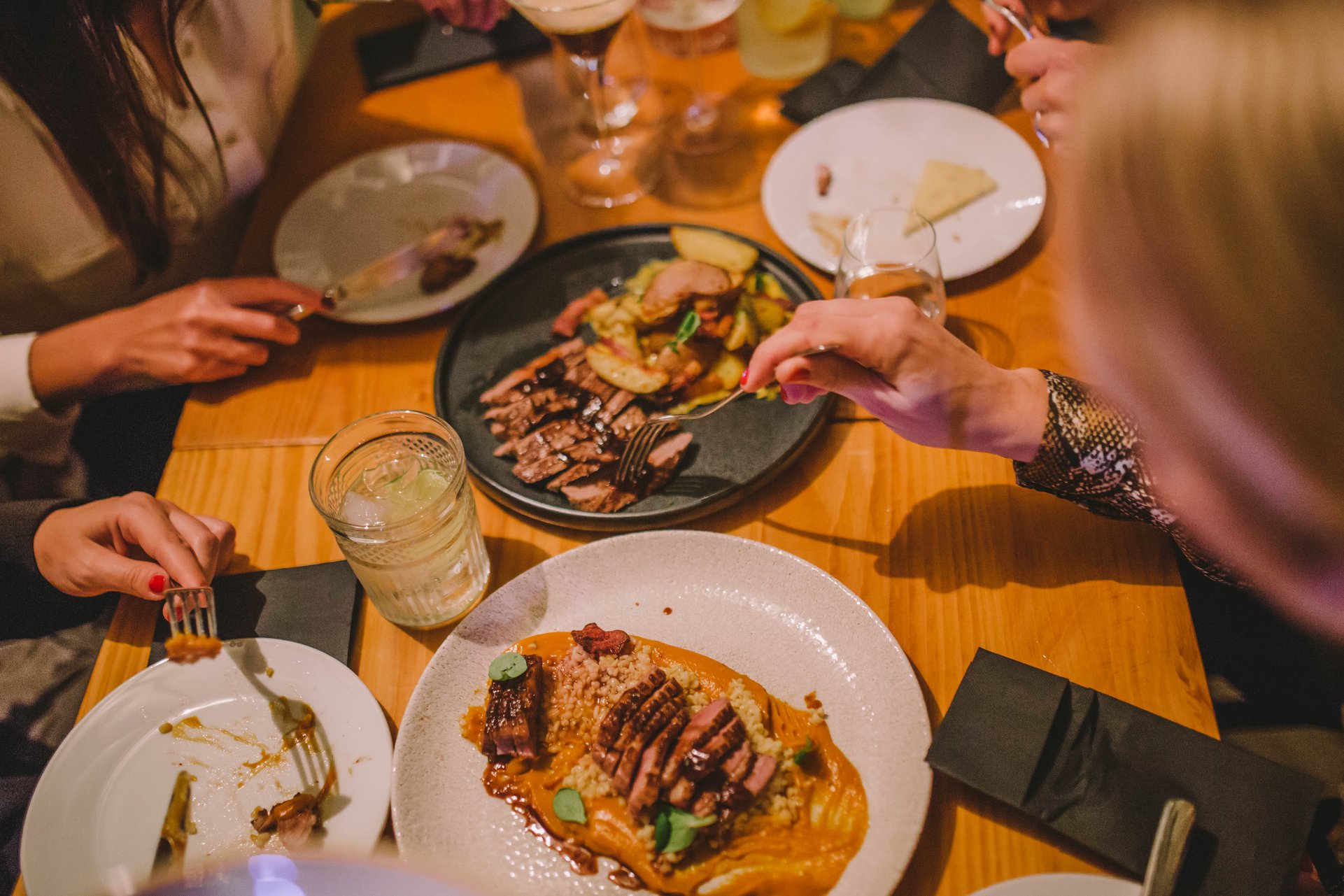
APPETIZER
1. Viennese Tartar - veal steak, horseradish, carrots, homemade ketchup
2. Red mullet ceviche - fennel cream, leek, rosemary powder
3. Parmesan risotto - cream of grana padano cheese, aceto balsamico, winter salad, espuma of grana padano
MAIN COURSE
1. Homemade Spaghetti - caramelized butter, dried tomatoes, truffle, grana padano, pine nuts
2. Lamb - slow-cooked lamb, potato cream, broad beans, pickled onions
3. European bass baked in parchment paper - mini tomato, zucchini, leek, carrot, posip
DESSERT
1. Polenta pudding - fruit salad with baked sabayon
2. Kadaif cannoli - pastry cream, caramel, pistachio
3. Lemon tart - walnuts, vanilla ice cream, meringue
You can see all the Restaurant Week menus here.
To read more about lifestyle in Croatia, follow TCN’s dedicated page.
Croatian Cultural Institutions Cancel Events Until April
March 12, 2020 - Croatian cultural institutions and other organizations have decided to cancel or postpone a series of events, given the recommendation to limit gatherings of more than a hundred people, announced by Health Minister Vili Beros as a new measure to curb the spread of coronaviruses.
Rijeka's HNK and GKL suspend programs
Croatian National Theatre Ivan Zajc has decided to suspend all its programs due to the coronavirus outbreak.
According to a statement from the CNT, "given the current situation with the coronavirus and the decision of the Civil Protection Headquarters to introduce new measures, the entire program will be postponed.”
The audience can follow the announcements on the official website of the theater for possible changes. The theater is working on revising the repertoire and will soon announce alternate dates and/or refunds.
Projects of great interest to the audience such as "Exercise Life - Second Time / Esercitazione alla vita - seconda volta", which is due to premiere next Tuesday, the “Evita” musical, long-awaited concerts, as well as projects in preparation and performances of the repertoire, will be on the program as soon as the conditions are created.
The Rijeka City Puppet Theater also canceled regular performances of "Zamrznute pjesme" on March 12, 13, 14, in all terms, and performances of "Gdje su nestale čarapice?" wil not run on March 17, 18, 19 and 20.
Audiences who have already purchased their tickets can ask for a refund by reporting to the box office during the box office hours, daily from 9 am to noon.
The presentation of the Electronic Music Ambassador Awards, scheduled to take place on March 19 at Rijeka's Culture Facility as part of the European Capital of Culture program, is delayed.
The ReTox panel "Accessibility and the City”, which was due to take place on March 13, is also being postponed with a new date for May 15 and a concert "Evening of the Sound" in memory of Linda Zezelic - Zeronik.
The Croatian National Theater in Split and the Museum of the City of Split have also been closed until further notice.
The Croatian National Theater (HNK) has not yet decided on the eventual delays or cancellations. They point out that they are in contact with the county civil protection headquarters, are listening to their recommendations, and the performances will eventually be held.
"We put up posters in the theater, we will put up disinfectants. However, we have not been instructed to limit the gatherings to accommodate more than one hundred people. If filled to the last place, our theater can accommodate 660 people," said a spokesman for the Split theater, Davor Vuković.
The director of the City Museum of Split, Branka Brekalo, said that the museum is closed from today for all events until further notice, but the museum, gallery and basements of Diocletian's Palace will be open to visitors. As of last night, the museum has disinfectants and protocol notices for all visitors.
Other city museums, galleries and institutions have also taken, or are about to do the same, to provide maximum protection to visitors who come to their premises, and as far as larger gatherings are concerned, they are largely forbidden until further notice.
The cultural institutions of Dubrovnik are wary of adhering to the recommendation to cancel international performances, postponing the performance of the Slovenian Mini Theater and the premiere of "Rita Klaus" from Berlin, scheduled for March 15 and 21.
The Dubrovnik Symphony Orchestra will host a concert of young musicians scheduled for Friday at Fort Revelin in a tight circle of parents and professors, while the concert at the University of Dubrovnik is postponed.
The opening of one exhibition has been postponed in the Dubrovnik museums and no other public events are held.
Currently, Dubrovnik cinemas have not canceled screenings, and activities in Dubrovnik libraries are being held as normal, but these are institutions with a smaller number of visitors.
Source: Glas Istre
To read more about lifestyle in Croatia, follow TCN's dedicated page.
Archaeological Survey of Old Town Hall in Split Complete, Renovation Begins
March 12, 2020 - The archaeological survey of the Old Town Hall within the EU project "Palace of Life - a City of Change" was the best insight into the rich historical life of Pjaca in Split.
The City of Split reported that the archaeological survey of the Old Town Hall within the EU project "Palace of Life - a City of Change" lasted one month. Investigations were conducted to discover and protect archaeological layers and structures prior to the renovation and restoration of this building in the heart of Split, in Pjaca.
What the archaeological survey employees of the Split company Temenos discovered was the best insight into the precious historical life of Pjaca, once known as People’s Square, and the changes that took place within the medieval town hall and that part of Split.
According to an archaeological report, it was discovered that the centerline of the town hall was preserved from the time before Diocletian's Palace was built. The remains of materials from an ancient road leading from the west door of the Palace were also found.
The construction of the first pre-Romanesque houses was also found, after the church of St. Lawrence in the 6th / 7th century and the formation of a medieval cemetery, and in the Romanesque period, during the Split commune, in the 12th and 13th centuries, there was an expansion and increase of houses.
With the arrival of the Venetian authorities and the construction of the Gothic town hall and the prince's palace and the demolition of the church of St. Lawrence, the People's Square got a new look.
The research also revealed that the original layout of the Old Town Hall was a unique space, which was later reconstructed.
The renovation and valorization of the Old Town Hall is part of the strategic EU project of the City of Split "Palace of life - City of changes" which integrates the development program of the visitor infrastructure of the historic core with Diocletian's Palace, which was submitted at the end of November 2019 by Ministries of Regional Development and European Union Funds under the ITU Mechanism, within the Operational Program "Competitiveness and Cohesion 2014-2020".
The renovation and restoration of the Old Town Hall are worth 9.6 million kuna, and the works should last 12 months. Everything is done with the consent and under the watchful eye of the Conservation Department in Split.
To read more about lifestyle in Croatia, follow TCN's dedicated page.
VIDEO: New Infrastructure Projects to Relieve Traffic Chaos in Split?
March 11, 2020 - The urban area of Split will become the largest construction site for transport infrastructure after the Peljesac Bridge.
Dalmacija Danas reports that most of the projects at the Croatian Government session on May 4, 2018, concerned transport infrastructure. The detection of black traffic points, their planning and design, is in the final stages, and construction is expected to begin by the end of the year.
According to the Croatian Roads procurement plan for 2020, 523.9 million kuna is planned for investments in transport infrastructure in the area of Split's urban area.
Arranging and leveling of the intersection of Širina in Solin, which records the daily flow of vehicles at an average of 46,941, is an absolute priority of Croatian Roads and the start of public procurement for construction is in the second half of 2020, with a project value of 135 million kuna. This project and the reconstruction of the Stobrec junction is also important because it forms the northern and eastern entrance to Split.
Solinska Street and Zagorski Put were re-categorized into state roads D432 and D433, respectively, on February 14, 2020, and are expected to be reconstructed and completed in 2021. These two roads form an alternative entrance to the city and make a significant contribution to solving traffic jams at the entrance to Split from the Solin direction.
The construction of the Mravinci junction - 2.5 km long TTTS junction with connected roads are extremely important for easing the direction towards Omiš, i.e., this section becomes a true Split bypass. The construction of the Mravinci rotor is also important to realize the regional waste management center project in Lećevica, relocating the Promet garage to Dračevac, as well as implementing the Dračevac technology park project. The value of this project is 336.8 million kuna, and is currently in the process of obtaining a location permit, while the start of procurement for the first phase is expected in the second part of the year.
The Mravince rotor would also become a new entrance to Solin, especially for parts of Solin such as Mravince, Kucina and Priko Voda. It is to these residents of Solin that the future Mravinac ramp would provide safe and fast access. The project, worth 15 million kuna, is in the phase of obtaining a location permit and construction is expected to begin at the end of 2020.
The western ramp at the entrance to the city of Split would allow direct access to Poljicka Street from Ul. Zbora narodne garde, i.e., the present Split bypass. They are currently in the process of finalizing the design, and works on this important ramp are expected early next year. This project would certainly solve the traffic jams that have formed at the entrance to Split for years. The value of the construction of the western ramp is 35 million kuna. The citizens of Split will also be pleased with the reconstruction of Poljicka Street, which includes rehabilitating the Visoko - Mertojak landscapes, reconstructing some intersections, new bicycle paths, bus stops, as well as a lot of new urban equipment. The project is in the preparation phase. Croatian Roads has decided to include all interested parties when planning this project, especially the city districts and the City of Split, city companies, and others.
The 2020 procurement plan also includes a project for a new exit from the ferry port. It is a two-lane road that would allow faster and safer exit from the ferry port directly Bijankinijeva ul. bypassing the Adriatic Bridge.
All of these projects included in the procurement plan are a guarantee that Croatian Roads are determined to resolve traffic congestion in the area of Split's urban agglomeration, the company said.
To read more about lifestyle in Croatia, follow TCN's dedicated page.
Split For Kids: Play and Learn about Split
March 10, 2020 - A new map helps your kids learn about the rich history of Split.
More than 1,700 years ago, Roman Emperor Diocletian built himself a palace close to his birthplace, but even he could never have dreamt that it would grow into such a wonderful city as Split. Today, Diocletian's Palace is not a museum; it's the heart of Split, open to everyone, and among its guests are many families with children. That was exactly the intention of the Tourist Board of Split to offer something completely new to children - a city map with content aiming at children and families traveling with kids. However, this map offers even more - to learn about the rich history of Split in a way suitable for children.
This map will be available in all Information Centers of the Tourist Board of Split. It includes locations of cultural institutions suitable for kids, like museums and theatres, but also other content, like sport facilities, playgrounds, spaces for outdoor activities, workshops, beaches, etc. On the map's opposite side you can see the historical city center with Diocletian's Palace. Short, simple texts describe the city's most important landmarks; Basement Halls, Peristyle, Palace Gates, Bishop Gregory's statue, Sphynxes, markings hidden on old town's walls, and many more. Following directions, any child will be able to solve simple tasks that make a stroll around the Palace even more fun. The slogan chosen for the map, 'Play and Learn About Diocletian's Palace,' speaks for itself.
Of course, one of the important goals of this map is promotion. The Tourist Board used it to invite children and their parents to post their photos of Split landmarks on social media, using hashtag #SplitForKids. That way, they will spread a word about Split and invite children to become friends of the city.
Author: Split Tourist Board / Ivica Profaca
To read more about lifestyle in Croatia, follow TCN's dedicated page.
HNL Round 26 Recap: Hajduk Drops to 4th Place after Adriatic Derby Loss
March 10, 2020 - The 26th round of the Croatian First League was played from March 7-9, 2020. This round featured the ‘Adriatic Derby’ between Rijeka and Hajduk, which Rijeka won at Rujevica Stadium.
Inter Zapresic v. Slaven Belupo (0:2)
Inter and Belupo opened the 26th round in Zapresic on Friday, March 7, 2020, in front of 136 fans.
Bogojevic scored the first goal of the game in the 28th minute for 0:1, while Lulic increased the lead in the 43rd minute for the final score of 0:2 for Belupo.
Inter is currently in 9th place with 17 points, while Belupo is in 7th with 26.
Osijek v. Varazdin (2:0)
Osijek and Varazdin met on Saturday, March 7, 2020, at City Garden Stadium in front of 1,715 fans.
Osijek scored both goals in the first half - Loncar scored in the 25th minute, while Maric made it 2:0 in the 27th.
Osijek is currently in 5th place with 42 points, while Varazdin is in the last place with 17 points.
Dinamo v. Istra 1961 (2:0)
Dinamo and Istra met on Sunday, March 8, 2020, at Maksimir Stadium in front of 2,474 fans.
Dilaver scored in the 2nd minute for an early 1:0 lead. Majer increased Dinamo’s lead to 2:0 in the 69th minute for the final score of the game.
Dinamo is currently in 1st place with 65 points, while Istra is in 8th with 19.
Rijeka v. Hajduk (2:0)
Rijeka and Hajduk met on Sunday, March 8, 2020, at Rujevica Stadium in front of 7,326 fans.
Both of Rijeka’s goals came in the second half - Colak scored for 1:0 in the 61st minute, while Gorgon scored 11 minutes later in the 72nd for 2:0.
Rijeka has jumped over Hajduk to 2nd place with 47 points, while Hajduk has fallen to 4th place with 45 points.
Gorica v. Lokomotiva (1:3)
Gorica and Lokomotiva closed out the 26th round on Monday, March 9, 2020, in Velika Gorica in front of 1,357 fans.
While the first half went without goals, Steenvoorden scored for the Gorica lead in the 53rd minute, though Atiemwen equalized in the 62nd for 1:1.
Uzini scored two goals in the 75th and 87th minutes for the Lokomotiva win.
Gorica is currently in 6th place with 35 points, while Lokomotiva has moved to 3rd place with 46.
You can see the full HNL table here.
To read more about sport in Croatia, follow TCN’s dedicated page.


